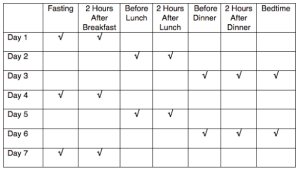Blood Glucose Goals and Monitoring
 Food choices, physical activity, and medications work together to control your blood glucose. Self-monitoring of blood glucose (SMBG) will show you how different foods, quantities of food, and physical activity all affect your blood glucose. It will also guide necessary changes.How often you should SMBG is individualized and will depend on your current level of diabetes control, your medications, activity level, and other factors. The goals of SMBG are to help you identify blood glucose patterns and to see how various foods, activities, and situations affect you. Below is a sample schedule that can help you identify blood glucose patterns.You may benefit from a schedule like this when you are first learning about diabetes, changing your diet or activity level, or taking new medications (or even altering your dose of medication). Once you are in good control, you may not need to SMBG so often. However, if you take insulin more than once daily to control your diabetes, then you may need to measure your blood glucose even more frequently.Some people want to measure blood glucose only before breakfast. While this gives important information, it does not provide a full picture. Your fasting blood glucose (first thing in the morning before eating, drinking, or exercise) shows your general level of blood glucose control and indicates how your medications affect your blood glucose. It does nothing, however, to show you what food and exercise are doing.You're advised to SMBG both before and after meals to assess the effects of food. The difference between the two numbers is largely the effect of the meal. Measuring only the after-meal blood glucose does not tell the whole story. For example, if your after-lunch measurement is 238 mg/dl, then you might think that it's high because of your choice of lunch. However, perhaps your blood glucose was elevated before you even had your first bite of food. A post-meal measurement of 238 mg/dl means something different if your pre-meal blood glucose was 200 mg/dl than if your pre-meal measurement was 125 mg/dl.By Jill Weisenberger, MS, RDN, CDE
Food choices, physical activity, and medications work together to control your blood glucose. Self-monitoring of blood glucose (SMBG) will show you how different foods, quantities of food, and physical activity all affect your blood glucose. It will also guide necessary changes.How often you should SMBG is individualized and will depend on your current level of diabetes control, your medications, activity level, and other factors. The goals of SMBG are to help you identify blood glucose patterns and to see how various foods, activities, and situations affect you. Below is a sample schedule that can help you identify blood glucose patterns.You may benefit from a schedule like this when you are first learning about diabetes, changing your diet or activity level, or taking new medications (or even altering your dose of medication). Once you are in good control, you may not need to SMBG so often. However, if you take insulin more than once daily to control your diabetes, then you may need to measure your blood glucose even more frequently.Some people want to measure blood glucose only before breakfast. While this gives important information, it does not provide a full picture. Your fasting blood glucose (first thing in the morning before eating, drinking, or exercise) shows your general level of blood glucose control and indicates how your medications affect your blood glucose. It does nothing, however, to show you what food and exercise are doing.You're advised to SMBG both before and after meals to assess the effects of food. The difference between the two numbers is largely the effect of the meal. Measuring only the after-meal blood glucose does not tell the whole story. For example, if your after-lunch measurement is 238 mg/dl, then you might think that it's high because of your choice of lunch. However, perhaps your blood glucose was elevated before you even had your first bite of food. A post-meal measurement of 238 mg/dl means something different if your pre-meal blood glucose was 200 mg/dl than if your pre-meal measurement was 125 mg/dl.By Jill Weisenberger, MS, RDN, CDE
